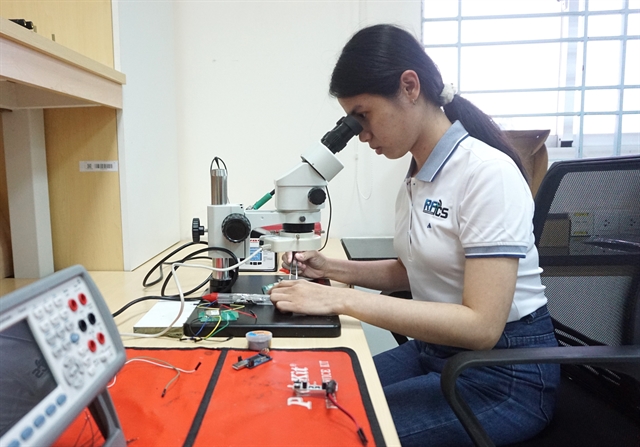Currently, Việt Nam has around 6,000 engineers working in the semiconductor industry for both domestic and foreign enterprises.
HÀ NỘI — The southeast region has been enjoying a great chance to develop the semiconductor chip industry thanks to its endless efforts to improve human resources for the industry and visits of technology giants to study investment opportunities there.

Promoting local advantages
Late last year, Saigon Hi-Tech Park in HCM City granted an investment certificate to Dutch BE Semiconductor Industries N.V. (BESI) to manufacture semiconductor equipment components.
A representative of BESI revealed that the company decided to rent a 2,000-metre ready-built factory in the park and pour more than US$4.9 million into the 50-year project in the first phase, vov.vn reported.
The US Semiconductor Industry Association (SIA) and leaders of major US semiconductor companies such as Intel, Qualcom, Ampere and ARM also paid a visit to the park to learn about high-tech development infrastructure, especially in the semiconductor industry that US firms had an interest in.
Meanwhile, in early 2024, Lạc Hồng University in Đồng Nai Provine and Sun Edu Co teamed up to establish a semiconductor chip centre to train high-quality human resources, conduct scientific research and transfer technology, promoting the development of the province’s semiconductor chip industry.
In October 2023, the US-based Coherent Corp proposed bringing high-tech projects in advanced optics, measurement, and semiconductor component manufacturing to Đồng Nai.
The company aimed to support these high-tech projects by focusing on cultivating a highly skilled workforce and ensuring the availability of key utilities and services such as electricity, water and IT, all fundamental elements that would foster an attractive investment climate, Vietnam Investment Review newspaper cited Steve Rummel, senior vice president of Coherent, as saying.
According to experts, Đồng Nai had many advantages in developing the sector such as a favourable geographical location, good traffic connections, abundant human resources and many high-tech operating enterprises.
Deputy Chairman of Đồng Nai People’s Committee Nguyễn Sơn Hùng said that his province had been concentrating on developing infrastructure, facilitating science and technology transfer, and improving the quality of human resources in science and technology.
The province had built a mechanism to develop the semiconductor chip industry, focusing on drawing up open policies, developing sufficient infrastructure, and ensuring smart management in parallel with attracting investment, Hùng said.
He added that his locality would also encourage universities to provide high-quality human resources for the semiconductor chip industry.
At the same time, Bình Dương, another southeast province, also considered semiconductor chips one of its important industries.
Nguyễn Lộc Hà, deputy chairman of the provincial People’s Committee, said participating in the value chain of the semiconductor chip industry was a must and also a top priority for Bình Dương, helping the locality realise its socio-economic development goals in the next stages.
Human resource training a must
Head of Saigon Hi-tech Park in HCM City Nguyễn Anh Thi said the southeast region including HCM City had huge potential to develop the semiconductor chip industry.
However, to take advantage of the opportunity, HCM City needs to improve the skills of about 40,000 engineers from now to 2030, or about 6,000 engineers each year.
He said the park has recently cooperated with Vietnam National University-HCM City and other schools to deploy R&D activities, training, and incubation of high technology.
Besides the city, Bình Dương Province also had a lot of potential to develop human resources for this industry, Thi added.
Đồng Nai Province’s Deputy Chairman Hùng agreed. He told a Vietnam News Agency correspondent that developing highly qualified personnel resources for the industry was very important and needed to be done quickly and comprehensively, from basic research to management, teaching, training and practice, and linking extensive support resources from a team of domestic and international experts.
Currently, Việt Nam has around 6,000 engineers working in the semiconductor industry for both domestic and foreign enterprises.
The country aims to train 50,000 highly-skilled engineers between now and 2030, with a particular focus on those specialising in semiconductor chip design. — VNS